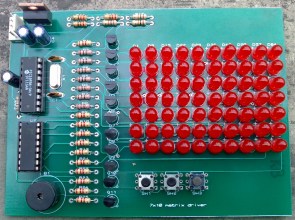Welcome to:
|
|
|
This is P1 of a 4-page newsletter P2 P3 P4
This website is constantly being updated and
new projects are being added all the time. They are included in the
index on the left, in alphabetical order as this is the quickest
way to find things. We only understand two ways to sort things:
numerical and alphabetical.
TALKING ELECTRONICS Interactive CD
Combinational Logic. The whole page structure is a mess (it comes from a University), but maybe you can work your way through the pages and get all the information. Here are some of the links: http://www.ee.surrey.ac.uk/Projects/Labview/common/map.html http://www.ee.surrey.ac.uk/Projects/Labview/Sequential/Course/04-State_Dia/state1.html http://www.ee.surrey.ac.uk/Projects/Labview/Sequential/Course Weekly Newsletter Send your email address for a weekly update newsletter. Lots of projects and pages are being updated all the time but the major additions are: Testing Electronic Components The Transistor Amplifier Videos - a whole range of interesting videos has been created by Dave L Jones 12 Digit Running Sign create running messages on a 12 digit calculator display. Pen Bug MkIV - a surface mount RF transmitter that fits inside a marker pen 1-9-2010 Latest Issue of Surface Mount Technology. Just look at the on-line features of being able to read the magazine on the screen. This is programming at its utter brilliance. Read this SCAM article on FREE ENERGY via a magnetic generator. The video does not show any generator working! The testimonials from readers say they have saved thousands in electricity bills but there are no videos!!!!! They must think we are total idiots! Simply show us a generator on a table illuminating a 100 watt globe. Here is a site that covers scams like this: SCAMS. (look under Deceptions) Run Your Car on Water: .pdf .rar .zip (the .pdf normally costs $25.00) Another SCAM: Tesla's Secrets. This $49.00 .pdf is filled with factual history of Tesla's life but the comments about FREE ENERGY are very suspect and energy detected in the video from the simple diode and antenna project represents the energy from TV stations, mobile phone towers etc - the energy is minûte. A-Z of Electronics - lots of details on everything electronic. 30-7-2010 Mechanical TV. Build a project that reproduces the very first 1930's TV. It was mechanical, and an enormous achievement.  There are hundreds of articles on Talking Electronics website. Email Colin Mitchell if you are looking for something in particular. Pick A PIC Project - new projects added to this page 8-6-2010 Watch this video: Time Click HERE to learn about PIC microcontrollers. Do not buy any Solar Panel System as new high-efficiency solar panels are just around the corner at 10% of the present cost. PIC Programmer MkV - very low cost programmer 15-5-2010 Pick A PIC Project - get yourself into PIC programming with lots of projects PIC Projects - lots of new projects 15-5-2010 Added more to Discussions - the cost of fuels added 13/5/2010 Bike and Car Gears Gives a readout of the gear on a display 21-3-2010 LED FX 12 different effects in a set of 3 LEDs (click on LED FX in menu) The most comprehensive eBook on the 555: 50 - 555 Circuits 13-2-2010 More projects using PIC micros. See Elektor. 13-2-2010 Stroop Game - A very interesting challenge 1/9/09 Power Management CookBookII from Texas Instruments .pdf 3.7MB Dial Alarm-2 kit dials 2 phone numbers and listens to audio in target zone 1-10-09 Electronic Goldmine has lots of interesting "junk" items each month. The elephant pump is based on the rope pump, first invented 2,000 years ago in China. It can be built in about four hours from local materials. This video shows how one is built and installed. You learn something new every day! Added new project: Counter for Lifts - counts entry and exists 11/8/2009 More added to PIC Programmer (now has In-Circuit Programming) 5-8-2009 More circuits added to PartB of ebook "200 Transistor Circuits" 21-7-2009 All About Circuits theory for Beginners Sparks Fun Catalogue - hundreds of interesting items (13MB .pdf) Whistle Key Finder added 18/7/2009 A great new site has popped up: GADGET GANGSTER 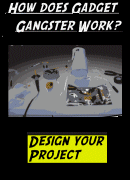 Put your project on their site and get paid 20%. You can even modify some of our designs and submit them for others to enjoy. We don't mind you coping any of our projects, provided you improve them and change some of the features. GADGET GANGSTER introduces a lot of "devilish enthusiasm" and really puts a lot of interest into the field of electronics. If you combine the skills of designing a project (with a microcontroller) and submit it to their site, you will get your "name in lights" and you can add one more "ticket to your achievements." I tried GADGET GANGSTER website today and it has GONE!! This website was run by a very clever electronics enthusiast who had put an enormous amount of time into designing a lot of very clever and interesting projects. But he has gone because absolutely no-one bought any of his kits. That is the way things are going. Sales of electronics projects and components have dropped to less than 10% of previous sales. One Indian electronics magazine has stopped selling kits and the other magazine obviously does not sell very much as they want $50 postage for a $5.00 kit. Elektor has resorted to only 6 issues a year in an attempt to save printing costs and Everyday Practical Electronics gets all their projects from Silicon Chip one year after they have appeared in SC. EPE subscriber base has dropped to less than 10,000 and I stopped producing my magazine when sales fell to 12,000 as it was no longer viable. The only thing that keeps Silicon Chip active is the sales of editorial material to EPE and when one goes, the other will follow. However the internet has boosted the interest in electronics enormously. It is free and reaches all over the world TE is still getting 6,000 to 7,000 visitors each day and each section gets almost the exact number of visitors each day. Some get 300, some get 200 and some get 50. And these numbers remain almost absolutely constant. Statistics is an amazing thing. If you don't believe in statistics, you are fooling yourself. Even page 28 of Spot the Mistakes gets 10 readers each day and this is after readers have covered more than 350 faulty circuits. We are constantly getting confirmation emails to say the reader has learnt more from Talking Electronics website than anything in any course. But don't forget each website costs a small amount to keep running and unless they are supported by purchases, they will close down. That's what happened with GADGET GANGSTER. 2 Digit Up/down Counter P2 P3 added 18/6/2009 Added more to Discussion-1 - the cost of fuels added 13/6/2009 Added more to Discussion-11 - jokes added 13/6/2009 12 FREE PIC Books Only 7 still available. Download via Rapidshare. Lots of PIC micro information on this website. Electronics Design Magazine. List of Authors. added 14-6-2009 An interesting opto-electronics magazine: Opto-IQ added 14-6-2009 Learn the basics of English and maths at Teachnology Here is a well-laid-out .pdf for semiconductors/pricing/function from Jameco (2.6MB) New Site for kits just appeared on the web: Kitstop. More details soon. More circuits added to PartB of ebook "200 Transistor Circuits" 1-6-2009 Download whole site $10.00 You can download the whole site for $10.00 and get a FREE CD of the whole site posted to you (this new feature is in response from a number of readers). A good electronics design site: Design News added 14-5-2009 Here's a great site for a lot of basic information: PCB Heaven Schematic Circuit Archive: PCB Heaven - circuits archive 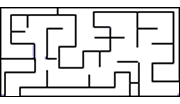 How many times are you going to watch the ball? More Sayings added to Discussion 11 5-5-2009 Lots of interesting videos on YouTube: Added more to page 9 of: "Spot the Mistake" 3/5/09 More circuits added to PartB of ebook "200 Transistor Circuits" 27-4-2009 Do you believe a car can "run on water?" Read-up on all the "truths" and "scams" about HHO, "Brown's Gas" and all the related topics on running your car on water. Start with this article: Scientific proof debunking the "run your car on water" scams then go to all the other links. It's fascinating reading. What is Atanua? 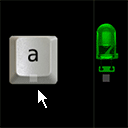 Atanua is a free
real-time logic simulator for individual use. It is designed to help learn basic Boolean logic and electronics. Atanua is a free
real-time logic simulator for individual use. It is designed to help learn basic Boolean logic and electronics.
See the interactive flash demo! Discussion on the Atanua forums! Download: (Atanua is free for personal, noncommercial use. See license for details.) Atanua win32 1.0.081116 Personal Edition More added to page 9 of: "Spot the Mistake" 25/3/09 How transistors REALLY work! The transistor was really invented in 1920's. We have been tricked!!! Added more to 555 article: P1 P2 P3 & test How many black dots:  Discussion-groups and forums can answer almost all your problems in an instant: Here is a forum: http://www.electro-tech-online.com A very handy set of parts to help you create your own circuit diagrams, by Tony van Roon:  More circuits added to PartB of ebook "200 Transistor Circuits" 12-1-2009 Added more to page 9 of: "Spot the Mistake" 9/1/09 Circuits added to PartB of ebook "200 Transistor Circuits" 27-12-2008 Sign up for weekly newsletter from Instructables - It's fantastic! Added more to Discussions - the cost of fuels added 13/12/2008 Added more to page 8 of: "Spot the Mistake" 4/12/08 More added to: Start Here with PIC16F628 microcontroller - 5/12/08 The first issue of Make Magazine to show you the contents added 22-11-2008 A new ebook "Beginners Guide To Electronics" 22-11-2008 Added more to page 8 of: "Spot the Mistake" 17/11/08 Finalised PartA of ebook "200 Transistor Circuits" 17-11-2008 Added Crystal Locked FM Bug project 7-11-2008 More added to: ebook "200 Transistor Circuits" 18-10-2008 15 minute Printed Circuit Board Kit $75.00 Interesting Microcontroller Site Funny Photos and articles - just to give you a "break." Added "Data Book 1" 27/9/08 4MB .pdf e-book. Nearly 100 pages of info etc Added more to 27MHz Transmitters - make your own 27 or 303MHz link 21/9/2008 Added more to page 8 of: "Spot the Mistake" 13/9/08 Added more to Discussions The biggest fraud in the world. Read about it. 12/9/08 A 5 minute video by Bre Pettis on building circuits on breadboard. Added 27MHz Transmitters - make your own 27MHz link 6/9/2008 Hundreds of Test Questions can be found at this site. Free Electronics Magazine - see below Added Wind-up Torch/Radio mistake to Spot the Mistake P8 2/08/08 Added Fundamentals of Electricity and Electronics - 23Meg .zip file - an invaluable presentation of over 1,000 pages of information. Everyone should download this file and learn the fundamentals of electronics! Added 15x7 Display 10/6/08 A great project using the PIC16F628 micro Added more to page 7 of: "Spot the Mistake" 2/2/08 Added a lot more to Elektor, EPE, Silicon Chip section 1/2/08 Added more to Library of sub-routines for PIC12F629 27/1/08 Added more to Solar Light 26/12/07 Added more to page 7 of: "Spot the Mistake" 26/12/07 Added Steam Engine Simulator 9/11/07 Added another Hearing Aid circuit 7/11/07 Added FM Bug 7/11/07 Added Earwig (Spy Bug) 7/11/07 Added more to page 7 of: "Spot the Mistake" 4/11/07 Added to Prototyping Boards 4/11/07 Added to Circuit Tricks 10/10/07 50 of the bests sites on the internet. These will keep you occupied for hours. Lots of new information on programming the PIC12F629 micro and new projects Added more to: Power Supply - The 12/9/07 Article: Spy Circuits FM Transmitters (and more to come) YouTube has some fantastic videos on soldering Surface-Mount Components. Article: Touch Switch Circuits added 20/8/07 More added to P3 of 555 article (subscription section) Added more symbols to Circuit Symbols 12/8/07 Added Energy Discussion to Discussions 12/8/07 Added 1.5v LED Flasher to Flasher Circuits 12/8/07 Added pages to Circuit Tricks 10/8/07 The Inductor - more added to P3 21/6/07 Added more items to page 6 of: "Spot the Mistake" 6/6/07 Added OP-AMP links to links page. 5/6/07 Discussion P11 - more jokes added 3/6/07 Added CD 4017 animation to Chip Data eBook 1/6/07 Added more items to page 5 of: "Spot the Mistake" 1/6/07 Infinity Bug Modifications added 11/5/07 Jim Rohn's Weekly E-zine - get a subscription to this interesting business magazine. T- Rays - the ray of the future - added 12/12/06 US Navy Electronics Course - added 7/12/06 White LED Drive Circuits Electronics Index - from A to Z - extremely valuable resource - added 27/11/06 Electronic projects from Make Magazine Make Magazine - lots of projects A Free Downloadable eBook on Electronics called: "Fundamentals of Electronics" Oled website - the latest in displays - added 17-10-2006 New article: Diesel Sound added15-10-2006 New article: Tunnel Stretcher added10-10-2006 New article: Level Crossing Lights added10-10-2006 New article: Charging NiMH Cells New project: Logic Pulser - ideal for testing digital circuits New project: Battery Charger 12v SLA (Sealed Lead Acid) - added 22/09/06 4049 and 4069 added to Chip Data eBook added 8/9/06 New project: Wireless Doorbell - added 5/09/06 Article on OIL added to: Discussion P15 - added 4/09/06 PCB123 Lead Free PC Boards - that's "Pb" free on the solder lands Two new links on our left-hand index: ElectronicsTeacher Electronics for Beginners New Project. PIR Camera. A digital camera takes photos when movement is detected by a PIR. - added 23/07/06 New Article: Discussion P15 - added 4/05/06 New Article: The Power Supply 5/2/06 - Includes the new 97% efficient "7805" A new Printed Circuit Board program has been released by:  Download Now New project: Stress Meter - added 11/01/06 A PIC12F629 project Robot Links (see: Articles by Other Authors) - 0ver 1,000 links Articles by Other Authors An amazing collection of very interesting articles. New project: Power Supply 5v Solar - added 24/12/05 New Surface Mount Board - added 23/12/05 Basic Electronics Course - P79 P80 (subscription needed) - added 23/12/05 Spot the Mistake P4 - new item added 22/12/05 Library of sub-routines for PIC12F629 microcontroller - added 22/12/05 Resistors Made Easy - added link-resistor (zero ohms) 22/12/05 Circuit Symbols - new symbols added 19/12/05 Start Here with PIC12F629 microcontroller - added 15/12/05 Circuit Symbols - new symbols added 12/12/05 Spot the Mistake P4 - new item added 5/12/05 The Inductor - Table of Inductance values - added 4/12/05 Bug Detector - Detects FM Transmitters - added 3/12/05 P67 of BEC course - added Timer delay circuit 2/12/05 Solar Light - Solar Garden Light article added 2/12/05 Surface Mount - all about surface mount devices. Added 16/11/05 Infinity Bug Project added 14/11/05 Transistor Data Page added 10/11/05 Discussion P11 - additional comment Spot the Mistake P4 - new item added Discussion P14 - the art of soldering the new lead-free (Pb-free) way. Spot the Mistake P1 diagram 9 Cracking a PIC Chip Diagram 11 on Page 12 of PIC Theory. Resistors have been increased to 120R 2-Input Alarm - uses a PIC chip P1 Basic Electronics Course - P79 P80 (subscription needed for access) Newsletter P4 Discussion P12 Discussion P13 - the art of learning a subject Flasher Circuits - Start with the simplest circuit: A LED Flasher PCB Survey - Pad2Pad manufacturers PC boards. Do you make your own PCB's? Spot the Mistake P4 Chip Data eBook has been updated from 470KB to 570KB. Download the eBook. Hundreds of "Test Questions:" This site provides hundreds of test questions on electronics: http://www.ibiblio.org/kuphaldt/socratic/doc/topical.html
SOLDERING IRON
If you use fine solder and apply the solder at the joint, the flux will clean the surfaces and create a very quick, clean connection. Using fine solder improves the connection 200% and using a temperature-controlled iron is 200% easier than using a big, cumbersome, cheap $8.00 iron. I have improved my soldering 400% and yours will improve 400% by simply using a fine tipped iron at 320°C to 360°C. Lead-free solders are extremely hard to use and make a very dull connection. The connections are very prone to failure and the temperature needed for this type of solder (soldering) is 40°C higher than 360°C and is very near the "destruction-point" for semiconductors. . Here's an interesting article, I just received: HISTORY OF THE CAR RADIO Seems like cars have always had radios, but they didn't. Here's the story: One evening, in 1929, two young men named William Lear and Elmer Wavering drove their girlfriends to a lookout point high above the Mississippi River town of Quincy, Illinois, to watch the sunset. It was a romantic night to be sure, but one of the women observed that it would be even nicer if they could listen to music in the car. Lear and Wavering liked the idea. Both men had tinkered with radios (Lear served as a radio operator in the U.S. Navy during World War I) and it wasn't long before they were taking apart a home radio and trying to get it to work in a car. But it wasn't easy: automobiles have ignition switches, generators, spark plugs, and other electrical equipment that generate noisy static interference, making it nearly impossible to listen to the radio when the engine was running. One by one, Lear and Wavering identified and eliminated each source of electrical interference. When they finally got their radio to work, they took it to a radio convention in Chicago. There they met Paul Galvin, owner of Galvin Manufacturing Corporation. He made a product called a "battery eliminator", a device that allowed battery-powered radios to run on household AC current. But as more homes were wired for electricity, more radio manufacturers made AC-powered radios. Galvin needed a new product to manufacture. When he met Lear and Wavering at the radio convention, he found it. He believed that mass-produced, affordable car radios had the potential to become a huge business. Lear and Wavering set up shop in Galvin's factory, and when they perfected their first radio, they installed it in his Studebaker. Then Galvin went to a local banker to apply for a loan. Thinking it might sweeten the deal, he had his men install a radio in the banker's Packard. Good idea, but it didn't work -- Half an hour after the installation, the banker's Packard caught on fire. (They didn't get the loan.) Galvin didn't give up. He drove his Studebaker nearly 800 miles to Atlantic City to show off the radio at the 1930 Radio Manufacturers Association convention. Too broke to afford a booth, he parked the car outside the convention hall and cranked up the radio so that passing conventioneers could hear it. That idea worked -- He got enough orders to put the radio into production. WHAT'S IN A NAME That first production model was called the 5T71. Galvin decided he needed to come up with something a little catchier. In those days many companies in the phonograph and radio businesses used the suffix "ola" for their names -Radiola, Columbiola, and Victrola were three of the biggest. Galvin decided to do the same thing, and since his radio was intended for use in a motor vehicle, he decided to call it the Motorola. But even with the name change, the radio still had problems: When Motorola went on sale in 1930, it cost about $110 uninstalled, at a time when you could buy a brand-new car for $650, and the country was sliding into the Great Depression, (By that measure, a radio for a new car would cost about $3,000 today.) In 1930, it took two men several days to put in a car radio --The dashboard had to be taken apart so that the receiver and a single speaker could be installed, and the ceiling had to be cut open to install the antenna. These early radios ran on their own batteries, not on the car battery, so holes had to be cut into the floorboard to accommodate them. The installation manual had eight complete diagrams and 28 pages of instructions. Selling complicated car radios that cost 20 percent of the price of a brand-new car wouldn't have been easy in the best of times, let alone during the Great Depression --Galvin lost money in 1930 and struggled for a couple of years after that. But things picked up in 1933 when Ford began offering Motorola's pre-installed at the factory. In 1934 they got another boost when Galvin struck a deal with B.F. Goodrich tire company to sell and install them in its chain of tire stores. By then the price of the radio, with installation included, had dropped to $55. The Motorola car radio was off and running. (The name of the company would be officially changed from Galvin Manufacturing to "Motorola" in 1947.) In the meantime, Galvin continued to develop new uses for car radios. In 1936, the same year that it introduced push-button tuning, it also introduced the Motorola Police Cruiser, a standard car radio that was factory preset to a single frequency to pick up police broadcasts. In 1940 he developed the first handheld two-way radio -- The Handy-Talkie --for the U. S. Army. A lot of the communications technologies that we take for granted today were born in Motorola labs in the years that followed World War II. In 1947 they came out with the first television for under $200.In 1956 the company introduced the world's first pager; in 1969 came the radio and television equipment that was used to televise Neil Armstrong's first steps on the Moon. In 1973 it invented the world's first handheld cellular phone. Today Motorola is one of the largest cell phone manufacturers in the world. And it all started with the car radio. WHATEVER HAPPENED TO the two men who installed the first radio in Paul Galvin's car? Elmer Wavering and William Lear, ended up taking very different paths in life. Wavering stayed with Motorola. In the 1950's he helped change the automobile experience again when he developed the first automotive alternator, replacing inefficient and unreliable generators. The invention lead to such luxuries as power windows, power seats, and, eventually, air-conditioning. Lear also continued inventing. He holds more than 150 patents. Remember eight-track tape players? Lear invented that. But what he's really famous for are his contributions to the field of aviation. He invented radio direction finders for planes, aided in the invention of the autopilot, designed the first fully automatic aircraft landing system, and in 1963 introduced his most famous invention of all, the Lear Jet, the world's first mass-produced, affordable business jet. (Not bad for a guy who dropped out of school after the eighth grade.) Sometimes it is fun to find out how some of the many things that we take for granted actually came into being! AND It all started with a woman's suggestion!! from: Mcclung Boatwright boatmac19311@bellsouth.net Pad2Pad Printed Circuit Board Poll Results: We have had lots of replies. Many hobbyists have paid for a professional PCB and been very satisfied with the end-result. But there's one thing you must remember. If the project is fairly complex, you may need to modify the circuit, add components, change the layout or alter the tracks. And this means your first effort may need a second or third board. If you think you can go from a circuit diagram to a PC board, and everything will work, you are kidding yourself. Unless you have made lots of projects and know exactly what you are doing, most circuits will not work the first time. There are lots of things that will prevent it from working - depending on the complexity and the frequency of operation. Things creep in like stray capacitance or positioning of components and you may need a second or even a third prototype, before you are satisfied with the performance. And will add considerably to the cost of the project. To reduce the costs, I suggest the use of one of our Matrix Boards, such as the one shown below: 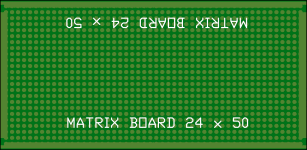 It has the order No: PK-MB2450 and by simply placing the components on the top side and connecting the pads with very fine tinned copper wire, you will produce a very neat layout. Don't forget to place the IC's in sockets so they are not damaged. You can even re-use the board and the components, although many of the parts will have very short leads, so the additional cost of prototyping will be very low. Once you are satisfied with the operation of the circuit, you can copy the layout using the CAD program provided by Pad2Pad and you will have a much greater chance of the circuit working perfectly the first time. Even if you are not in the need of a board at the moment, go to the site and download the program to create some artwork to get an idea of how to use it. All packages take a while to learn and it's best to get some experience before you need make a board - so you don't get frustrated when the pressure is on. Try it as soon as you can, you will be impressed with the features. PERPETUAL MOTION Do I believe in Perpetual Motion? Yes. Do I believe it is here? No. There has not been any scientific evidence that any device can rotate indefinitely without any input-energy or produce any output without any input-energy. We have got very close (even to the extent of 99.9%) but that magical figure of 100% has not been obtained. That doesn't mean we should not keep trying, but as a practical person I prefer to explore the potentials of using the vast amount of energy that already surrounds us. The sun provides 1kw per square metre on a brightly-lit day, the wind provides considerable energy in a windy location and the tide, waves and streams provide enormous potential for harnessing energy. So, to get down to practicalities, let's consider the energy from the sun in the form of solar-cell voltage production and heat via solar-heat collection. (You will need to go to other websites for solar-heat production as we are very interested in this area but it does not involve electronics.) Some of the new projects we are working on include charging storage cells via a solar panel and using an inverter to provide charging when the panel is not producing a high output. See our solar projects in the index on the left side of the site and these will include links to other projects. MORE ON PERPETUAL MOTION I received an email from Richard L. "Scott" McKie -- scotsman7@comcast.net inventor of a "Perpetual Energy Machine" patent number: 5,146,395 When I asked him for a video, photograph and evidence of his actual working prototype he just sent me a rude email: "go ------- yourself." If you look at the patent and circuit diagram it is just a mixture of empty boxes and circuit components that make no sense at all. It is something that will impress the uninitiated and in his email he was touting for an investor. I have received over a dozen letters like this and they are all just as fraudulent. Suppose his isn't fraudulent. Suppose he had a box of tricks that produced 5kw. How much do you think it would be worth? Absolutely nothing. A project like this could be copied and produced within a week. You have no hold on anyone copying anything. I already produce 1.5kw mains inverters for $300 and sell them for $1,960. Anyone could produce "Perpetual Energy Machines" in a garage and no-one could find them. To think you could stop a person or close them down is just a dream. All my kits were copied by a "business acquaintance" in Hong Kong and I could do nothing. The same with the "Perpetual Energy Machine." After you sell the first device, the mystery is over. The final email I sent him was: I will buy one for $50,000. If the idea was genuine, he could supply a prototype or mock-up and claim $50,000. We will see what reply is received. My emails have now been rejected. He has got an inefficient mail server: comcat.net claiming my emails are SPAM. UPDATE: No actual replies to my emails but just more abuse. It makes you wonder how an intelligent person can act like this. The "Inventor" wants to lease the product and wants a backer to manufacture it. Who would release such a valuable product for 1% of its value on a lease agreement when you can sell it for 100% of its value!! Secondly, who would be running around looking for a a "backer" when one demonstration on a TV program would generate 1,000 immediate investors. It makes you wonder how an intelligent person could write a spiel for a patent and not have enough intelligence to run the business-end of the "invention." Invention-assistance FRAUD I almost got caught by the Davison Invention assistance company. I have a number of products that need development and Davison had sent me emails as to how they had assisted so many inventors with their inventions. It all sounded "so easy." I sent them an outline of the idea. It was an electronic module for greeting cards. When you open the card, it contains a game such as a Reaction Timer to test your reaction. Two pressure-sensitive buttons and a 7-segment display tested the players timing. The 7-segment display was made from LEDs and was low-profile. The module needed to be made in tens of thousands to keep the price low. Davison looked at the idea and gave it the "go ahead." Then they phoned me with the spiel that they needed to do a patent search for $685. I said I could do that myself, and anyway these ideas cannot be found in any greeting cards. Davison said it was imperative that they do the search before taking on the idea. I told them that anyone taking on my invention would need to do their own "due diligence" and anything I provided would have to be verified by them. That was not good enough for Davison. I said I had absolutely no intention of parting with $685 for a search. Davison then hung up the phone on me. I then thought I would Google "Davison." What a surprise! A whole website has been set up, exposing the fraudulent behavior of this company. Some inventors have parted with $10,000 and more, developing prototypes and packaging so Davison can show a photo of all the products they have "developed." None of these products have actually reached the shop shelves. They are all prototypes in prototype packaging and some inventors have been strung along for 2 years! In this world, there are only two things you can rely on. And they are on the end of your own two arms. Getting an invention to market is not easy and is fraught with dangers and high costs. It certainly does not need a "Davison FRAUD" company to enter the picture. Even getting a thing produced overseas is not easy as most manufacturers have a range of products and they are not really equipped to produce something new. If you can find a company that produces something similar to yours, you have a slim chance that they can help, but most of the components in a product are made by other, smaller, companies and you will never be able to actually reach the manufacturer. Secondly, companies do not have the money to develop any of your ideas and the cost of development is very high. This means you will not make a cent out of the first 10,000 items and that's why you need to look at very large quantities. I don't want to put you off, but don't think any of the items in a $2.00 store have appeared overnight. Everything is a lot of work and even the packaging and labeling needs a considerable amount of attention. If you have any "electronic idea" that you want mass-produced, let me know as I have now found reliable contacts in China and the modules are getting organized. Get-Rich-Quick Schemes How do you know if a "Get-Rich-Quick Scheme" is a FRAUD? It's simple. They are ALL FRAUD. I am constantly being bombarded with emails on: "how to get rich quick." They are all either fraud or simply a business designed to "rope-in" your friends and family. Many of them are a "Pyramid Scheme" in which you get a commission when you get 5 or 10 friends to join. I have asked 3 promoters of "million dollar" schemes to fax me a copy of their Tax Return (the only true indication of their wealth). I have never received a reply. Before you join any "scheme," ask to see the Tax Return for the business. A non-reply will answer all your questions. The latest is a revised version of the "Nigerian Money Scam." It asks for assistance in transferring money into your account. If you see an email with "$1,000,000" on it, delete it immediately. This is the quickest way to get rid or your junk emails. I get hundreds like this EVERY DAY!
More Internet FRAUD
I get lots of emails from readers who have been with me
over the past 40 years or so and now they have children. And
they want their children to enjoy the excitement of learning
and delving into the fun of electronics.
Hi Colin,
Just wanted to say thankyou for all you've done for
electronics and education.
My own story:
I bought 'FM bugs' in a newsagent as a 12 year old
and was soon buying kits from you, soldering and
testing them, then selling them at school. I
enjoyed robots and programming through high school
and then studied electrical engineering at uni.
Although I'm not employed as an electrical engineer, I am actively enjoying it as a hobby, and often see the great quality material you've put free online when I'm searching for one circuit or another. I've put in a lot of effort to get my girls (now 16 and 18) into electronics and technology. You might enjoy reading the adventures we've had http://awesome.tech/day-3-of-the-worlds-largest-makerfaire/. I'm finishing the final bits and pieces and look forward to launching a Kickstarter to sell it as a kit worldwide. Hopefully I inspire a few people in the way that you have ! All the best and thanks again. Yours sincerely, Daniel Collins dan.col@gmail.com
00000000000000000000000000000000000000000000000000000
An email from a constructor: I have just completed another kit I purchased from you (my second PIC LICK). Excellent kit as usual! I usually use my own solder when soldering but this time I used the one in the kit. I found this solder to be excellent - far superior to the Kester type I am using. Could you to tell me what brand and where I can purchase it? For your information I have also built a couple of kits from Germany (KENO kits). They are complete junk! If I didn't need them for a client I would have thrown them in the garbage. Your kits are by far the best I have ever built, followed by CANAKIT and then by Quasar in England. Best regards, Rodney Luck
We are the first
kit manufacturer in Australia to provide solder with all kits. It is 0.71mm
diameter with 5 cores of flux. It improves the quality of your soldering by
at least 200% and makes you look like a professional. The secret is its
fineness. You will not believe how it will improve your soldering. Try it. I
did and I have never used thick
solder since. Another reader: Dear Colin,Electronics has been so confusing and difficult for me. But with the help of your site I am beginning to get clear with the subject. Thank you so much. I can't believe the effort you have put into creating this huge site with so much information. It's like a large university dedicated for electronic students. Thank you so much Collin, for your effort. Darshana adarshana123@yahoo.com My name is James, and I am writing this email to thank you for your wonderful website. You have taught me many things indirectly. If I had not discovered your website, Talking Electronics.com, I would not know nearly as much as I do now! I'll explain...
I have built over 50 circuits from your website.
Most of your transistor circuits, and around half
your 555 timer circuits. I have not had a problem
with any that you designed. Your schematics are very
easy to read, and I recommended a few to my friends
to get them started. I even featured most of
your circuits on one of my videos. You are a
wonderful designer. I am 18 years old and am
fortunate to have found your material at an early
age. Keep up the good work.
jbuddyman@gmail.com He has some videos on the web.
ooo0000ooo
Here's another email from a reader who has been buying Talking Electronics
magazines since 1988 and has now stumbled on our Talking Electronics
website: ooo0000ooo
Another reader:
DIYODE Magazine A CAREER |



